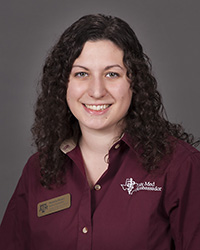Learning through Labs
 After the gauntlet of the first two years of veterinary school, it really is nice to experience some of the perks of third year. We get to put a lot of what we learned our first two years of school into use, especially during our lab periods. Just this past week, our Small Animal Medicine class had us practicing a procedure called a pericardiocentesis, a procedure that involves inserting a needle through the body wall and into the pericardium, the sac that surrounds the heart, so that the fluid can be drained. This may be necessary in certain patients to remove excess fluid to make them feel better and also so that the fluid can be tested to determine what may be causing the patient’s problem. My class was able to practice this on some pretty cool models that simulate how it will feel to perform the procedure in a live patient one day.
After the gauntlet of the first two years of veterinary school, it really is nice to experience some of the perks of third year. We get to put a lot of what we learned our first two years of school into use, especially during our lab periods. Just this past week, our Small Animal Medicine class had us practicing a procedure called a pericardiocentesis, a procedure that involves inserting a needle through the body wall and into the pericardium, the sac that surrounds the heart, so that the fluid can be drained. This may be necessary in certain patients to remove excess fluid to make them feel better and also so that the fluid can be tested to determine what may be causing the patient’s problem. My class was able to practice this on some pretty cool models that simulate how it will feel to perform the procedure in a live patient one day.
We previously had several large-animal labs. My favorite was the ophthalmology lab, which gave us practice in procedures with the equine eye. We were able to use live horses and do a full ophthalmic exam. We also practiced performing auriculopalpebral nerve blocks; these blocks involve injecting a small amount of lidocaine near the auriculopalpebral nerve, which will temporarily prevent the horse from blinking. Since we can’t ask the horse to hold his eye open for us like human doctors can, this nerve block is a very useful technique to learn, as it makes the exam more pleasant for the horse and also much quicker for everyone. We were then able to use an ophthalmoscope to perform a fundic exam to determine if the eye is healthy or if there are any problems.
In addition to our medicine labs, I also had a large-animal skills lab this semester, during which we were able to help improve our large animal-handling skills with cattle, pigs, goats, and horses and perform some of the routine procedures we will do as vets one day, such as trimming feet and drawing blood for testing. It was always the highlight of my week to work with these animals, as I plan on becoming a large-animal vet after I graduate. I even got to learn how to shoe a horse using a horse leg model that was more realistic than I ever could have anticipated. While farriers are often the ones who put shoes on horses, it was fascinating to learn how the process is done and important to understand so that we can properly care for horses who injure their hooves. Next semester I will have small-animal skills labs and I am looking forward to seeing what I will learn there. It’s really encouraging learning some of the skills I will be using on a daily basis when I am on clinics full-time next year. I can’t wait to see what I will learn next!
